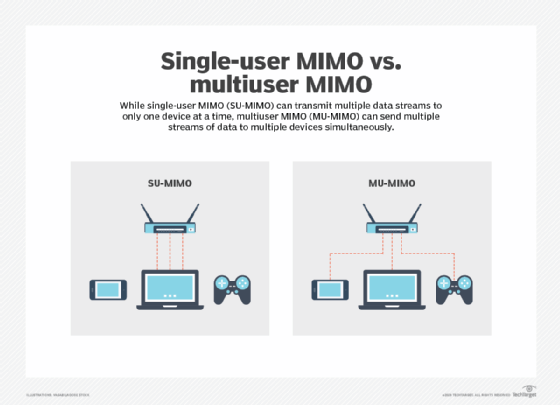single-user multiple input, multiple output (SU-MIMO)
What is single-user multiple input, multiple output (SU-MIMO)?
Single-user multiple input, multiple output (SU-MIMO) is a multitransmitter and receiver technology that lets a wireless access point (AP) send multiple, simultaneous data streams to one compatible endpoint at a time. SU-MIMO is typically compared with multiuser MIMO (MU-MIMO).
SU-MIMO began as part of the 802.11n wireless standard in 2007. SU-MIMO enables multiple data streams to be transmitted to or received between Wi-Fi devices.
In SU-MIMO, a device such as an AP or router uses multiple antennas to simultaneously send multiple data streams to a single endpoint device, such as a phone, laptop or tablet. When available bandwidth divides into multiple spatial streams, it increases the efficiency and reliability of transmissions.
SU-MIMO technologies also make use of MIMO functions, such as spatial multiplexing and beamforming, to direct and improve signal strengths.
For SU-MIMO to work, both the transmitting and receiving devices -- such as an AP and a laptop -- must support MIMO. That means both devices must have at least two antennas, which might be a burden for smaller devices, such as smartphones.
A potential downside to SU-MIMO compared to another strategy such as MU-MIMO is that SU-MIMO is only able to send multiple data streams to one device at a time.

How MIMO works
MIMO is an acronym that stands for multiple input, multiple output. MIMO divides into three groups:
- Spatial multiplexing.
- Precoding.
- Diversity coding.
Multiplexing is a way for networks to send multiple signals or streams of data over a communications link simultaneously in the form of a single signal. Networks use multiplexing to have multiple devices connect to each other and to stretch scarce network resources further.
Spatial multiplexing
Spatial multiplexing, used in SU-MIMO, splits a high-rate signal into multiple low-rate signals and transmits them via separate antennas at the same frequency channel. The number of possible data streams in spatial multiplexing is limited to the number of antennas at the transmitter and receivers. MU-MIMO can also use spatial multiplexing to transmit data to multiple receivers at the same time.
Precoding
MIMO uses precoding, which is multistream beamforming. Precoding is all the spatial processing that occurs in the transmitter. Beamforming increases signal gain and directs signals toward a wireless device.
Diversity coding
Diversity coding is a coding technique that sends multiple copies of data through multiple antennas at the transmitter. This improves reliability when there is no knowledge of the channel at the transmitter. When the receiver has some channel knowledge available, it can combine diversity coding with spatial multiplexing.
SU-MIMO vs. MU-MIMO
MU-MIMO is another, more advanced technology used for wireless communication between devices. It debuted in Wave 2 of the 802.11ac standard, also known as Wi-Fi 5.
MU-MIMO is mainly used to support environments where multiple users access the same wireless network at one time. MU-MIMO helps relieve potential congestion caused by multiple devices that create multiple connections to a device when they try to connect at the same time.
SU-MIMO transmits data streams to a single device at a time, while MU-MIMO can transmit data to multiple devices at the same time. In SU-MIMO, the number of antennas that transmit and receive limit any multiplexing gain. In MU-MIMO, however, multiplexing gain can scale with the number of transmit antennas used.







